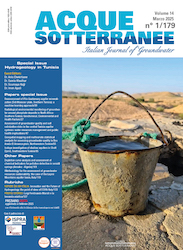 Smart Citations
Smart CitationsSee how this article has been cited at scite.ai
scite shows how a scientific paper has been cited by providing the context of the citation, a classification describing whether it supports, mentions, or contrasts the cited claim, and a label indicating in which section the citation was made.
Radiological environmental monitoring of groundwater around phosphate deposits in North Africa-Southern Tunisia: geochemical, environmental and health factors
Groundwater contamination is a global problem that has a significant impact on human health and environmental/biota services. Southern Tunisia’s atmospheric, sediments and deep hydrothermal naturally contain radioactive isotopes originating primarily from Eocene/Ypresian phosphate deposits and extracted from the great hydrothermal reservoir of North Africa (North Western Sahara Aquifer System). These apatite deposits can be enriched in Uranium-238 and its daughter isotopes. This can have harmful effects on both the human life and the environment. The changing climate amplifies the devastating impacts of nuclear radiation resulting from phosphate mining and industry sectors particularly in Southern Tunisia. The phosphate nodules carrying radioactive elements from the Eocene have been redistributed into more recent geological formations. This has led to their widespread distribution throughout the Tunisian southern region. The results of measurements relating to natural radioactivity in southern Tunisia demonstrate that the various components’ values (238U, 232Th, 226Ra, and 40K) show significant variations depending on the location (0.05 mSv/h < gamma radiation dose < 0.36 mSv/h in the air, 0.06 mSv/h < gamma radiation dose < 0.36 mSv/h in the soil and between 0.18-0.24 mSv/y in groundwater). However, the gamma radiation levels and the overall radioactivity are high in the vicinity of phosphate deposits exceeding the standards set by the International Atomic Energy Agency of 0.3 mSv/h. This is due to the persistent presence of a dusty cloud containing metallurgical and radioactive pollutants above the phosphate mines and the hydrothermal groundwater. Influenced by meteorological parameters such as wind velocity, temperature, fog, and precipitation, groundwater hydrodynamic circulation, such pollutants are transported to neighboring regions. Mining of the Eocene deposits and related activities caused rising levels of air, soil and groundwater radioactivity on the western side. Intensified contamination can manifest in various ways and may have severe impacts on the human health and the environment.
How to Cite

This work is licensed under a Creative Commons Attribution-NonCommercial 4.0 International License.
PAGEPress has chosen to apply the Creative Commons Attribution NonCommercial 4.0 International License (CC BY-NC 4.0) to all manuscripts to be published.








